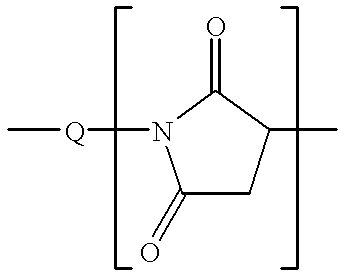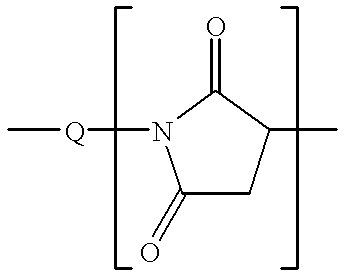Modified pigment products, dispersions thereof, and compositions comprising the same
a technology of modified carbon black and pigment products, which is applied in the direction of thermography, instruments, and photosensitive materials, can solve the problems of affecting the dispersion stability and other properties of bulk liquid, excess surfactant found in conventional pigments may also be detrimental to plastic or film-forming properties, and the use of modified carbon blacks comprising non-ionic groups is not disclosed in the application of printing plates
- Summary
- Abstract
- Description
- Claims
- Application Information
AI Technical Summary
Problems solved by technology
Method used
Image
Examples
example 1
Preparation of a Polymer
[0061]Maleic anhydride (17 g) and 230 g of a polyisobutylene of MW 1330 (available from Amoco, Chicago, Ill.) were heated with mechanical stirring under nitrogen for 18 hours at 200° C. The reaction mixture was cooled to room temperature, and 18.7 g of p-phenylenediamine was added. The reaction mixture was then heated for 4 hours at 200° C. After cooling, hexanes were added, some solids were removed by centrifugation, and the remaining solution was concentrated under vacuum. The polymer was N-(p-aminophenyl) polyisobutenylsuccinimide.
example 2
Preparation of a Polymer
[0062]Maleic anhydride (9.3 g) and 80 g of a polyisobutylene of MW 940 (available from Amoco, Chicago, Ill.) were heated with mechanical stirring under nitrogen for 18 hours at 200° C. The reaction mixture was cooled to room temperature, and 10.3 g of p-phenylenediamine was added. The reaction mixture was then heated for 3 hours at 200° C. After cooling, hexanes were added, some solids were removed by centrifugation, and the remaining solution was concentrated under vacuum. The polymer was N-(p-aminophenyl) polyisobutenylsuccinimide.
example 3
Preparation of a Modified Pigment Product
[0063]A solution of 1.87 g of NaNO2 in 100 g of water was added dropwise to a stirring mixture of 40.8 g of the polymer of Example 1, 300 mL of hexane, 2.60 g of methanesulfonic acid, and 40 g of carbon black. The carbon black had a surface area of 112 m2 / g and a DPBA of 60 mL / 100 g. When the addition was complete, the mixture was heated to 70° C. and the stirring was continued for an additional hour. The mixture was cooled and the aqueous layer was removed. The resulting material was a dispersion in hexanes of a modified pigment product, namely a modified carbon product, having attached polyisobutenylsuccinimidylphenyl groups. The product was purified with hexanes in a diafiltration apparatus having a porous carbon membrane.
PUM
| Property | Measurement | Unit |
|---|---|---|
| wavelengths | aaaaa | aaaaa |
| wavelengths | aaaaa | aaaaa |
| size | aaaaa | aaaaa |
Abstract
Description
Claims
Application Information
 Login to View More
Login to View More - R&D
- Intellectual Property
- Life Sciences
- Materials
- Tech Scout
- Unparalleled Data Quality
- Higher Quality Content
- 60% Fewer Hallucinations
Browse by: Latest US Patents, China's latest patents, Technical Efficacy Thesaurus, Application Domain, Technology Topic, Popular Technical Reports.
© 2025 PatSnap. All rights reserved.Legal|Privacy policy|Modern Slavery Act Transparency Statement|Sitemap|About US| Contact US: help@patsnap.com



